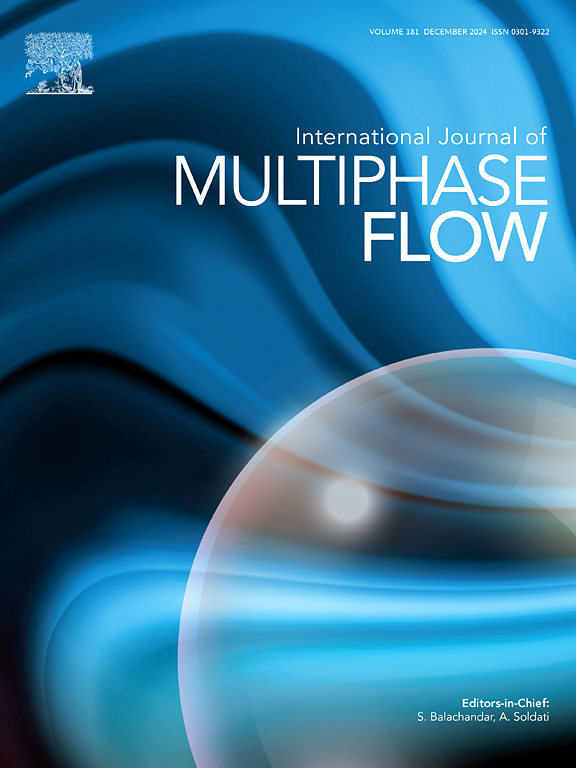Single-plume and multi-plume atomisation of ethanol with different levels of water content at hot fuel conditions
IF 3.6
2区 工程技术
Q1 MECHANICS
International Journal of Multiphase Flow
Pub Date : 2025-02-28
DOI:10.1016/j.ijmultiphaseflow.2025.105199
引用次数: 0
Abstract
Producing anhydrous ethanol involves separation of ethanol and water in an energy intensive process. It is possible to use ethanol (without any gasoline) as a fuel in countries where the ambient temperature is high enough that the low vapour pressure of pure ethanol does not give rise to significant cold weather driveability issues. From a cost and carbon footprint perspective, it is highly desirable to use hydrous ethanol, but there is a clear need to understand the effect of water content in ethanol on the spray formation process and hence mixture formation. The present paper presents results from an optical experimental investigation into the effects of 0–15 % water content per volume in ethanol on spray formation, using high-speed imaging and droplet sizing. Experiments were carried out with fuel temperatures in the range 20–110 °C at 1.0 bar and 0.5 bar gas pressure. Iso-octane and water were also tested for comparison. Multi-hole and isolated single-hole injections were studied to decouple effects from plume-to-plume interactions. Single-plume hydrous ethanol fuels showed initial delay out of the nozzle with shorter penetration but gradually achieved or surpassed the liquid penetration of the anhydrous fuel. Increased water content was generally associated with reduced single plume cone angle between 20 and 90 °C, but at 110 °C the order was reversed, with the hydrous ethanol blends having greater cone angle than the anhydrous which has implications for spray collapse upon multi-plume operation. At 20 °C, 1.0 bar, anhydrous ethanol showed larger droplets than iso-octane by ∼5 %, with the addition of 10 % water increasing the SMD by about a further 5 %. Water showed larger SMD than the fuels by 30–40 %. At 110 °C, 0.5 bar, all fuels showed smaller droplets by 20–30 % than at the subcooled condition. When comparing the isolated single-plume spray with the respective plume pair of the multi-hole experiment for anhydrous ethanol and iso-octane at subcooled conditions, it was observed that the plume pair had higher penetration. This could be attributed to near-nozzle effects from interacting adjacent plumes, differences in gas entrainment and drag. At superheated conditions, the penetration of the multi-hole plume pair for iso-octane was similar to that of the isolated single-hole plume spray. However, for ethanol it was clearly shorter due to presence of plume merging and initiation of spray collapse, effects that were absent for the single-plume configuration. The fact that increasing water content was associated with wider near-nozzle plume angle at superheated conditions and stronger propensity for plume merging and spray collapse, despite the slightly lower vapour pressure, suggests that other effects, e.g. related to the higher heat capacity of water and potential temperature saturation upon phase change, could dominate the process.

单烟羽和多烟羽雾化乙醇与不同水平的水含量在热燃料条件
生产无水乙醇需要在能源密集型过程中分离乙醇和水。在环境温度足够高的国家,使用乙醇(没有任何汽油)作为燃料是可能的,纯乙醇的低蒸气压不会引起明显的寒冷天气驾驶问题。从成本和碳足迹的角度来看,使用含水乙醇是非常可取的,但显然需要了解乙醇中含水量对喷雾形成过程的影响,从而影响混合物的形成。本文介绍了一项光学实验研究的结果,研究了乙醇中每体积0 - 15%的含水量对喷雾形成的影响,使用高速成像和液滴大小。在1.0 bar和0.5 bar气体压力下,燃料温度在20-110℃范围内进行实验。还测试了异辛烷和水进行比较。研究了多孔和孤立的单孔注入,以解耦羽流相互作用的影响。单羽含水乙醇燃料在出喷嘴时出现初始延迟,穿透时间较短,但逐渐达到或超过无水燃料的液体穿透时间。在20 - 90°C之间,含水量的增加通常与单羽锥角的减小有关,但在110°C时,顺序相反,含水乙醇混合物的锥角比无水乙醇混合物大,这意味着在多羽流操作时喷雾崩溃。在20°C, 1.0 bar时,无水乙醇的液滴比异辛烷大5%,添加10%的水可使SMD进一步提高5%。水的SMD比燃料大30 - 40%。在110°C, 0.5 bar时,所有燃料的液滴都比过冷条件下小20 - 30%。将分离的单羽射流与过冷条件下无水乙醇和异辛烷的多孔实验中各自的羽流对进行比较,发现羽流对具有更高的穿透性。这可以归因于相邻羽流相互作用的近喷嘴效应,气体夹带和阻力的差异。在过热条件下,异辛烷的多孔羽流对的穿透性与孤立的单孔羽流喷雾相似。然而,对于乙醇,由于羽流合并和喷雾崩塌的开始,它明显更短,而单羽流配置没有这种影响。在过热条件下,尽管蒸汽压略低,但含水量的增加与更宽的近喷嘴羽流角和更强的羽流合并和喷雾崩溃倾向有关,这表明其他影响,例如与更高的水热容和相变时的潜在温度饱和度有关,可能主导了这一过程。
本文章由计算机程序翻译,如有差异,请以英文原文为准。
求助全文
约1分钟内获得全文
求助全文
来源期刊
CiteScore
7.30
自引率
10.50%
发文量
244
审稿时长
4 months
期刊介绍:
The International Journal of Multiphase Flow publishes analytical, numerical and experimental articles of lasting interest. The scope of the journal includes all aspects of mass, momentum and energy exchange phenomena among different phases such as occur in disperse flows, gas–liquid and liquid–liquid flows, flows in porous media, boiling, granular flows and others.
The journal publishes full papers, brief communications and conference announcements.

 求助内容:
求助内容: 应助结果提醒方式:
应助结果提醒方式:


